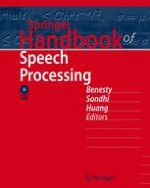2008 | OriginalPaper | Buchkapitel
48. Feedback Control in Hearing Aids
verfasst von : Ann Spriet, Dr., Simon Doclo, Ph.D, Marc Moonen, Prof., Jan Wouters, Prof.
Erschienen in: Springer Handbook of Speech Processing
Verlag: Springer Berlin Heidelberg
Aktivieren Sie unsere intelligente Suche, um passende Fachinhalte oder Patente zu finden.
Wählen Sie Textabschnitte aus um mit Künstlicher Intelligenz passenden Patente zu finden. powered by
Markieren Sie Textabschnitte, um KI-gestützt weitere passende Inhalte zu finden. powered by
